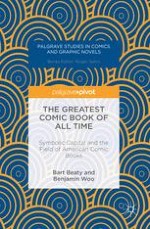2016 | OriginalPaper | Chapter
3. A Short Story by Robert Crumb?
Authors : Bart Beaty, Benjamin Woo
Published in: The Greatest Comic Book of All Time
Publisher: Palgrave Macmillan US
Activate our intelligent search to find suitable subject content or patents.
Select sections of text to find matching patents with Artificial Intelligence. powered by
Select sections of text to find additional relevant content using AI-assisted search. powered by
